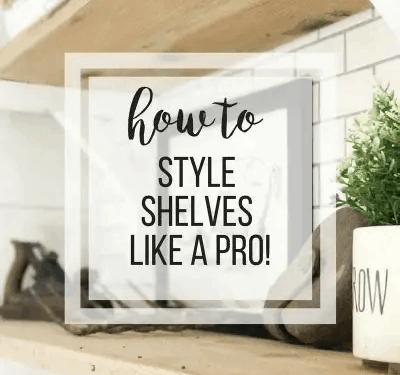
Delve into the art of expert shelf styling with our guide on How to Style Shelves Like a Professional Designer. From understanding the basics to creating balance and symmetry, this comprehensive overview will transform your shelves into curated masterpieces.
Whether you're a novice looking to elevate your interior design skills or a seasoned pro seeking fresh inspiration, this guide is your key to achieving stylish and sophisticated shelf displays.
Understanding the Basics of Shelf Styling
Shelf styling plays a crucial role in interior design as it not only adds functionality but also enhances the aesthetic appeal of a space. By carefully curating and arranging items on shelves, you can create a focal point, showcase your personality, and tie together the overall design of a room.
Key Elements to Consider When Styling Shelves
When styling shelves, it is important to consider the following key elements:
- Balance: Achieving a balance between different items in terms of size, shape, and color is essential to create a visually pleasing display.
- Texture: Incorporating a variety of textures such as wood, metal, glass, and fabric can add depth and interest to your shelves.
- Color: Selecting a color scheme that complements the existing color palette of the room can help create a cohesive look.
- Layering: Experimenting with layering items at different depths can create a sense of dimension and visual interest.
- Negative Space: Leaving some empty space on the shelves can prevent overcrowding and allow each item to stand out.
Enhancing the Overall Look of a Room with Shelf Styling
Properly styled shelves can enhance the overall look of a room by adding personality, warmth, and character. They provide an opportunity to display cherished items, books, art pieces, or plants, turning an ordinary shelf into a work of art that reflects your style and taste.
Additionally, well-styled shelves can create a sense of balance and harmony in the room, making it feel more inviting and visually appealing.
Selecting the Right Shelves and Display Items
When it comes to styling shelves like a professional designer, selecting the right shelves and display items is crucial. The choice of shelves and items can greatly impact the overall look and feel of a space.To start, let's discuss different types of shelves suitable for styling:
Types of Shelves
- Floating Shelves: These shelves create a modern and sleek look, perfect for minimalist or contemporary spaces.
- Open Shelving Units: Ideal for displaying a mix of decorative items and functional pieces, such as books or plants.
- Built-in Shelves: These shelves seamlessly blend into the room's architecture, providing a custom look.
Now, let's move on to tips for selecting shelves that complement the room's decor:
Tips for Selecting Shelves
- Consider the style of the room: Choose shelves that match the overall aesthetic, whether it's traditional, modern, or eclectic.
- Measure the space: Ensure the shelves fit the dimensions of the wall and leave enough room for the items you plan to display.
- Think about functionality: Select shelves that not only look good but also serve a practical purpose, such as storage or organization.
Lastly, let's share ideas on choosing display items that create visual interest:
Choosing Display Items
- Mix textures and shapes: Combine items of varying textures, shapes, and sizes to add depth and visual appeal to the shelves.
- Incorporate greenery: Plants and flowers can breathe life into the display, adding a touch of nature to the space.
- Showcase personal items: Display meaningful objects, such as family photos or souvenirs, to personalize the shelves and tell a story.
Creating Balance and Symmetry

In shelf styling, achieving balance is crucial to create a visually appealing display. Balance refers to the equal distribution of visual weight in a space, ensuring that no single item or side overpowers the rest.
To achieve symmetry in shelf styling, you can start by placing larger or taller items in the center and gradually decreasing the size towards the ends. This creates a sense of equilibrium and harmony in the arrangement. Additionally, you can use pairs of similar items on both sides of the shelves to create a mirror image layout.
Examples of Asymmetrical Shelf Styling
Asymmetrical shelf styling can result in a modern and dynamic look, breaking away from traditional symmetrical arrangements. Here are some examples of how to achieve asymmetry:
- Place a tall, statement piece on one end of the shelf and balance it out with a cluster of smaller items on the opposite side.
- Use varying heights and shapes of objects throughout the shelves to create visual interest and movement.
- Experiment with an off-center arrangement, where the focus is shifted to one side of the shelves rather than the center.
Mixing Textures, Colors, and Heights
When it comes to styling shelves like a professional designer, mixing textures, colors, and heights can take your display to the next level. By incorporating these elements thoughtfully, you can create a visually captivating and well-balanced arrangement that adds personality and interest to your space.
Mixing Textures
When selecting items to display on your shelves, consider mixing different textures to add depth and visual interest. Textures can range from smooth and shiny to rough and matte, creating a dynamic display that catches the eye. For example, you can pair a sleek ceramic vase with a woven basket or a glass sculpture with a wooden figurine to create contrast and tactile appeal.
Incorporating Colors
Color is a powerful tool in shelf styling, as it can set the mood, create cohesion, or add a pop of interest to your display. When selecting items, aim to incorporate a variety of colors that complement each other or follow a cohesive color palette.
Mixing different hues, shades, and tones can create a harmonious and visually pleasing arrangement. Consider using a mix of neutrals, pastels, and bold colors to add depth and dimension to your shelves.
Varying Heights
Varying the heights of items on your shelves is essential to creating a visually appealing display. By incorporating items of different heights, you can add dimension, movement, and balance to your arrangement. Taller items can anchor the display and draw the eye upwards, while shorter items can create layers and visual interest.
Experiment with stacking books, using risers, or incorporating tall vases to achieve varied heights and a well-balanced look.
Organizing and Grouping Items
When it comes to styling shelves like a professional designer, organizing and grouping items effectively is key to creating a visually appealing display. By strategically arranging your decor pieces, you can achieve a cohesive and balanced look that showcases your style and personality.
Grouping Similar Items Together
One effective strategy for organizing items on shelves is to group similar items together. This could mean arranging books with books, vases with vases, or candles with candles. By grouping items with similar shapes, colors, or themes, you create a sense of cohesion and harmony in your display.
Creating Focal Points
To add visual interest and create focal points within your shelf displays, consider incorporating statement pieces or unique items that draw the eye. This could be a bold piece of artwork, a decorative object with intricate details, or a pop of color that stands out against the rest of the items on the shelf.
By strategically placing these focal points, you can guide the viewer's gaze and create a dynamic and engaging display.
Adding Personal Touches and Greenery
When it comes to styling shelves like a professional designer, adding personal touches and greenery can elevate the overall look and feel of the display. These elements not only add a sense of uniqueness but also reflect the personality of the individual.
Significance of Personal Items
Personal items such as family photos, travel souvenirs, or heirlooms bring a sense of warmth and personality to the shelf display. They tell a story and make the space feel more lived-in and inviting.
Incorporating Plants and Greenery
Plants and greenery can bring a fresh and lively element to shelf styling. They add a pop of color, texture, and natural beauty to the display. Consider different types of plants like succulents, trailing vines, or fresh flowers to suit your style and space.
Unique Reflection of Personality
By adding personal touches like favorite books, unique collectibles, or handmade items, you can create a shelf display that truly reflects who you are. These elements make the space feel personal and curated, showcasing your individual style and taste.
Concluding Remarks
Master the art of shelf styling and unleash your creativity with the knowledge gained from this guide. Elevate your living spaces, showcase your personality, and create visually stunning shelves that will leave a lasting impression on all who behold them.
Answers to Common Questions
How can I choose the right shelves for styling?
Consider the room's decor and select shelves that complement the existing style. Opt for shelves that are both functional and visually appealing.
Why is it important to mix textures in shelf styling?
Mixing textures adds depth and visual interest to shelf displays, creating a more dynamic and engaging overall look.
Should I incorporate personal items in shelf displays?
Adding personal touches to your shelves can make them unique and reflective of your personality, adding a personal flair to your design.
How do I create focal points within shelf displays?
You can create focal points by strategically placing standout items or arranging certain pieces in a way that draws the eye and adds visual interest.











